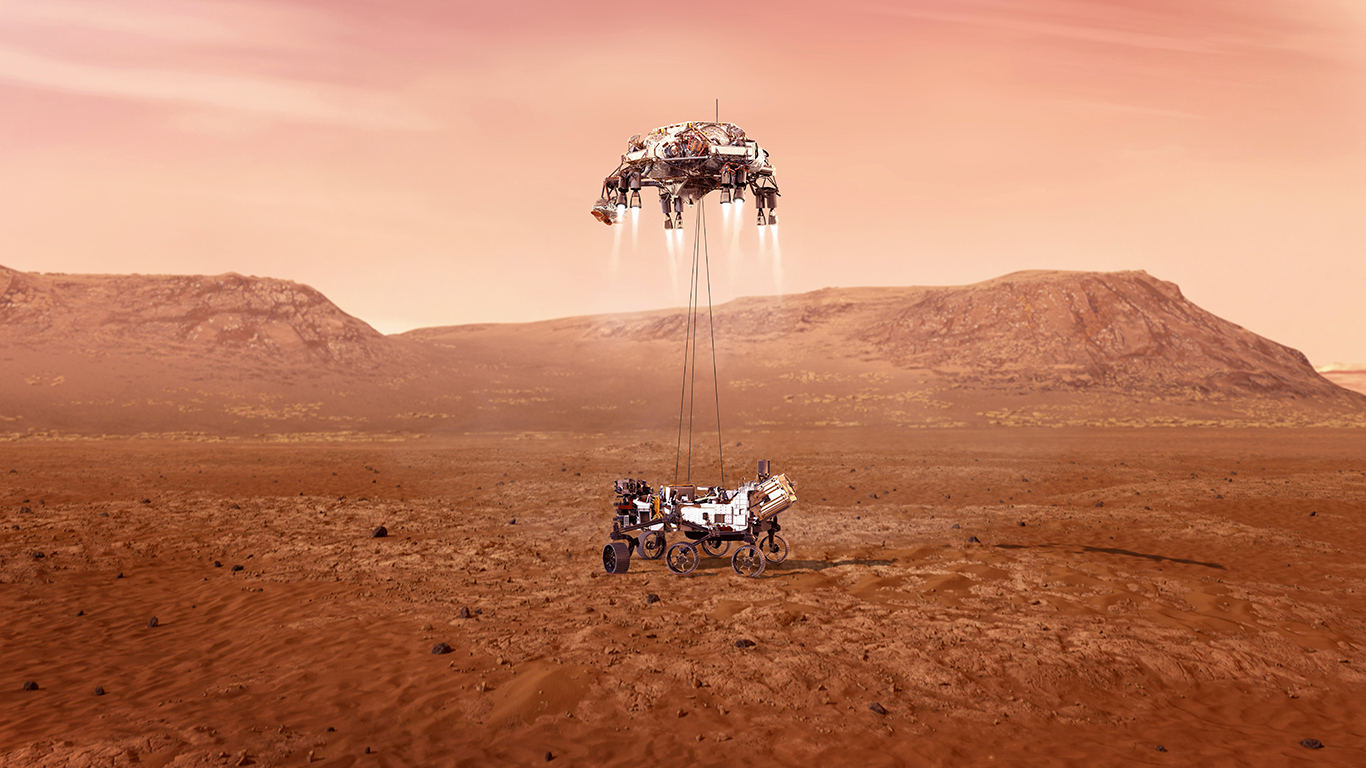
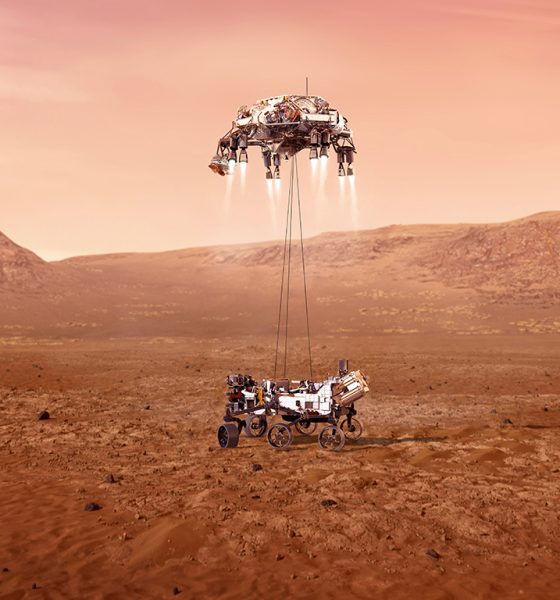
News
NASA braces for ‘7 minutes of terror’ as rover, rocket crane near Mars
NASA’s most ambitious – and difficult – Mars rover mission to date is nearly at the end of its interplanetary journey, but it is just the beginning of the excitement. On Tuesday (Feb. 16) engineers at NASA’s Jet Propulsion Laboratory (JPL) confirmed that Perseverance is doing well and is prepared to attempt a touchdown at about 12:55 p.m. PST (3:55 p.m. EST) on Thursday (Feb. 18).
NASA’s fifth Mars rover, Perseverance, will attempt a tried and true, but terrifying landing method to reach the Martain surface safely. In a process called entry, descent, and landing (EDL) the rover will burst through the Martian atmosphere at 12,500mph (20,000 kph) and slow to just under 2mph (3kph) in about seven minutes – a process which has earned the nickname “seven minutes of terror.”
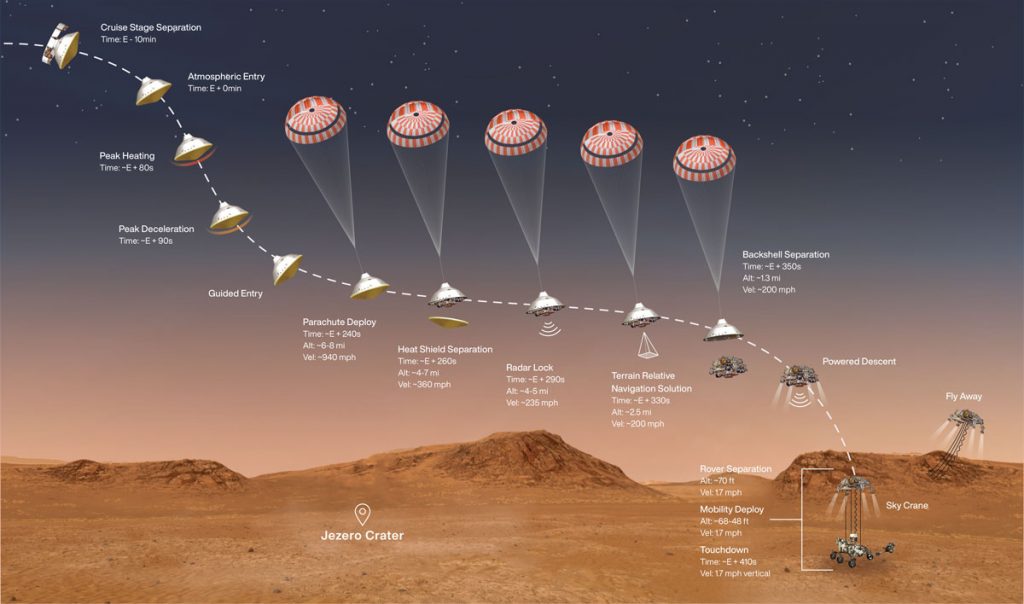
From interplanetary spacecraft to Martian rover in seven minutes
For the past seven months, Perseverance has traveled 300 million miles (480 million kilometers) as an interplanetary spacecraft. When it reaches its final destination of Mars on Feb. 18, the spacecraft will have to shed some layers to prepare to land on the Martian surface. Perhaps the most challenging part of the seven minutes of terror is that Perseverance will conduct every aspect autonomously – engineers back on Earth will not be able to intervene due to the communications time delay caused by the distance between Earth and Mars.
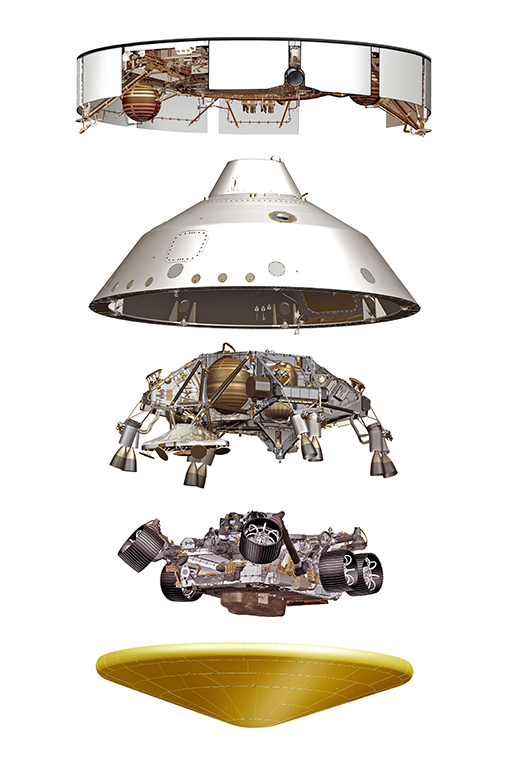
During the first stage of landing known as entry, Perseverance will slam into the relatively thin Martian atmosphere at the neck-break speed of 12,500mph (20,000 kph). At approximately 12:38 p.m. PST (3:38 p.m. EST), 10 minutes prior to entering the Martian atmosphere, the Cruise Stage which has reliably propelled Perseverance on its journey from Earth via solar power will separate. This will initiate the official transition from spacecraft into rover.
To protect the rover and its critical hardware Perseverance is housed inside of a protective covering – called an aeroshell – and is outfitted with a robust heat shield. Small thrusters at the crown of the aeroshell help to reorient itself and ensure that the heat shield is facing in the right direction as it enters the atmosphere. The aeroshell and heatshield will absorb and deflect the brunt of the heat energy – reaching about 2,370 degrees Fahrenheit (about 1,300 degrees Celsius) – caused by the friction of entering the Martian atmosphere at such a high velocity.
Once through peak heating and deceleration, Perseverance will utilize a new technology called Range Trigger to determine its exact location and distance to the surface. The spacecraft will utilize this technology to autonomously determine the optimal time to deploy its supersonic parachute – the largest ever sent to Mars – and separate its heat shield. This is expected to occur at 12:52 p.m. PST (3:52 p.m. EST). Once the heat shield has separated the powered descent stage – and the Perseverance rover itself – will be exposed to the Martian environment.

Although a similar descent method has been used in the past with the landing of NASA’s Curiosity rover in 2012, Perseverance’s way of doing things has received a major upgrade.
Once the heat shield has been dispersed, Perseverance will use a radar and cameras to utilize a new landing technology called Terrain-Relative Navigation. Essentially, Perseverance will continuously take images to map out the Martian surface as it descends to determine its exact location. The spacecraft will actively decide and target the best possible safe landing site which can be autonomously changed up to 2,000 feet (600 meters). Then the aeroshell and parachute are jettisoned and it’s the powered descent module’s time to shine.
Using rockets to land, rather than to launch
Just two minutes after ditching the heat shield, at 12:54 p.m. PST (3:54 p.m. EST) and only 1.3 miles (2.1 kilometers) above the surface, the powered descent stage will fire eight throttleable retrorockets to slow the spacecraft’s descent even more and steer it to its chosen landing target. During the powered descent phase, the spacecraft will slow from about 190 mph (306 kph) to just 1.7 mph (2.7 kph).
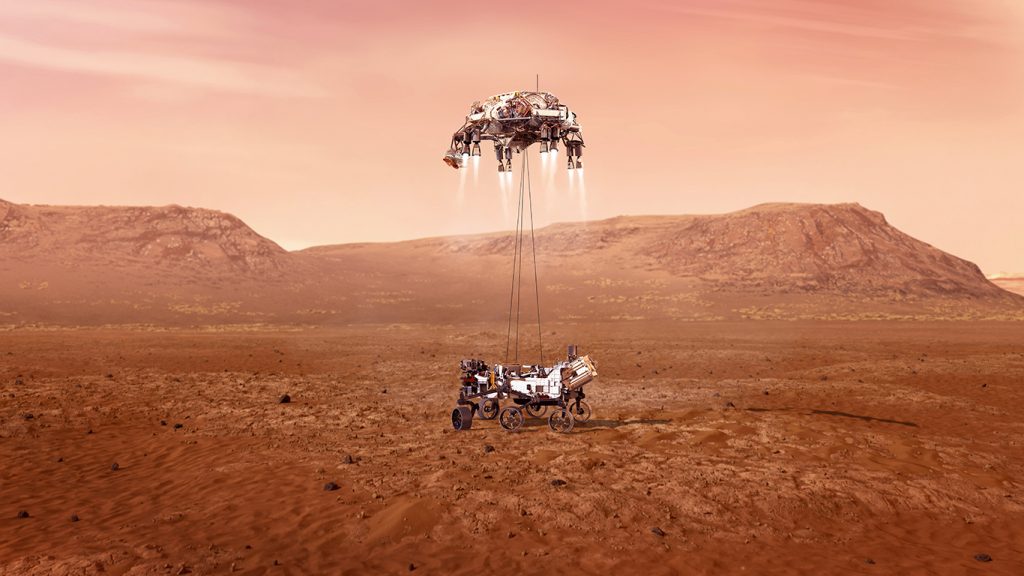
Once the spacecraft determines that it is 65 feet (20 meters) from the surface by utilizing the Terrain-Relative Navigation, the powered descent stage will initiate the sky crane maneuver. In this phase, the Perseverance rover will be delicately lowered to the Martian surface with a system of Nylon cords.
At 12:55 p.m. PST (3:55 p.m. EST) the $2.4 billion NASA Mars 2020 mission will officially touchdown on the surface of Mars in the Jezero Crater. Once safely down, the sky crane will severe the cords and fly off for a crash landing at a safe distance away from the rover.
During the landing attempt, NASA’s Mars Reconnaissance Orbiter will be overhead and constantly sending telemetry back to Earth via NASA’s Deep Space Network. The telemetry will indicate to engineers back at NASA JPL if the landing procedure was successful and will confirm a touchdown at 12:55 p.m. PST (3:55 p.m. EST).
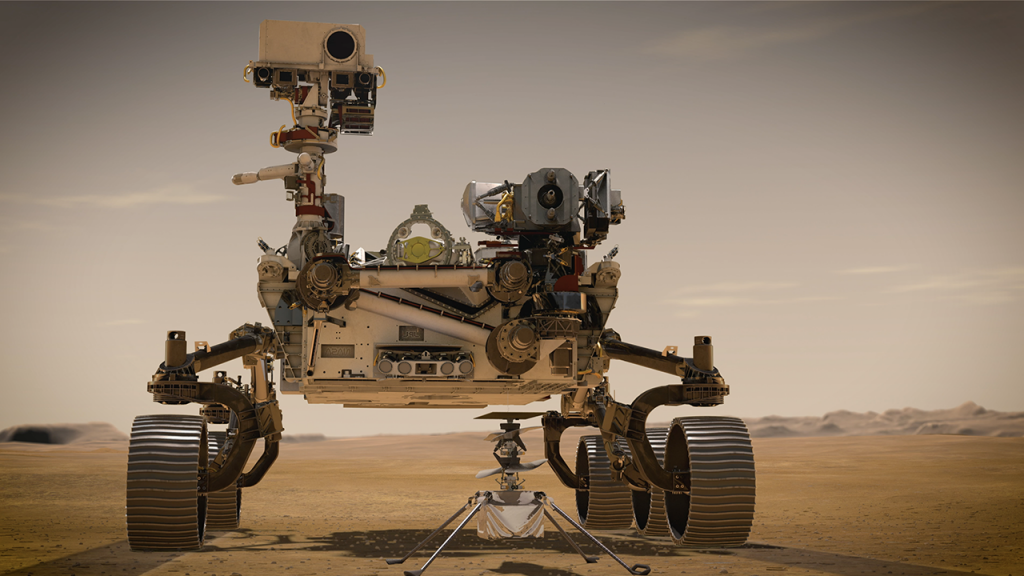
This will be the first time that a NASA Mars rover will be landing with its eyes open, so to speak. NASA hopes that the first images – and sounds – of the Martian landing will be available to release to the public within about an hour of confirmed touchdown.
Beginning around 11:15 am PST (19:15 UTC) on Thursday, February 18th, NASA will provide live coverage of Perseverance’s landing attempt. The agency will carry the coverage on NASA TV and its website, as well as a number of other platforms including YouTube, Twitter, Facebook, LinkedIn, Twitch, Daily Motion, Theta.TV, and the NASA app. You can view the entry, descent, and landing process in its entirety in the video below provided by NASA’s JPL.

Elon Musk
Elon Musk proposes Grok 5 vs world’s best League of Legends team match
Musk’s proposal has received positive reception from professional players and Riot Games alike.

Elon Musk has proposed a high-profile gaming challenge for xAI’s upcoming Grok 5. As per Musk, it would be interesting to see if the large language model could beat the world’ best human League of Legends team with specific constraints.
Musk’s proposal has received positive reception from professional players and Riot Games alike, suggesting that the exciting exhibition match might indeed happen.
Musk outlines restrictions for Grok
In his post on X, Musk detailed constraints to keep the match competitive, including limiting Grok to human-level reaction times, human-speed clicking, and viewing the game only through a camera feed with standard 20/20 vision. The idea quickly circulated across the esports community, drawing commentary from former pros and AI researchers, as noted in a Dexerto report.
Former League pro Eugene “Pobelter” Park expressed enthusiasm, offering to help Musk’s team and noting the unique comparison to past AI-versus-human breakthroughs, such as OpenAI’s Dota 2 bots. AI researcher Oriol Vinyals, who previously reached Grandmaster rank in StarCraft, suggested testing Grok in RTS gameplay as well.
Musk welcomed the idea, even responding positively to Vinyals’ comment that it would be nice to see Optimus operate the mouse and keyboard.
Pros debate Grok’s chances, T1 and Riot show interest
Reactions weren’t universally optimistic. Former professional mid-laner Joedat “Voyboy” Esfahani argued that even with Grok’s rapid learning capabilities, League of Legends requires deep synergy, game-state interpretation, and team coordination that may be difficult for AI to master at top competitive levels. Yiliang “Doublelift” Peng was similarly skeptical, publicly stating he doubted Grok could beat T1, or even himself, and jokingly promised to shave his head if Grok managed to win.
T1, however, embraced the proposal, responding with a GIF of Faker and the message “We are ready,” signaling their willingness to participate. Riot Games itself also reacted, with co-founder Marc Merrill replying to Musk with “let’s discuss.” Needless to say, it appears that Riot Games in onboard with the idea.
Though no match has been confirmed, interest from players, teams, and Riot suggests the concept could materialize into a landmark AI-versus-human matchup, potentially becoming one of the most viewed League of Legends events in history. The fact that Grok 5 will be constrained to human limits would definitely add an interesting dimension to the matchup, as it could truly demonstrate how human-like the large language model could be like in real-time scenarios.
Tesla has passed a key milestone, and it was one that CEO Elon Musk initially mentioned more than nine years ago when he published Master Plan, Part Deux.
As per Tesla China in a post on its official Weibo account, the company’s Autopilot system has accumulated over 10 billion kilometers of real-world driving experience.
Tesla China’s subtle, but huge announcement
In its Weibo post, Tesla China announced that the company’s Autopilot system has accumulated 10 billion kilometers of driving experience. “In this respect, Tesla vehicles equipped with Autopilot technology can be considered to have the world’s most experienced and seasoned driver.”
Tesla AI’s handle on Weibo also highlighted a key advantage of the company’s self-driving system. “It will never drive under the influence of alcohol, be distracted, or be fatigued,” the team wrote. “We believe that advancements in Autopilot technology will save more lives.”
Tesla China did not clarify exactly what it meant by “Autopilot” in its Weibo post, though the company’s intense focus on FSD over the past years suggests that the term includes miles that were driven by FSD (Beta) and Full Self-Driving (Supervised). Either way, 10 billion cumulative miles of real-world data is something that few, if any, competitors could compete with.
Advertisement
–>
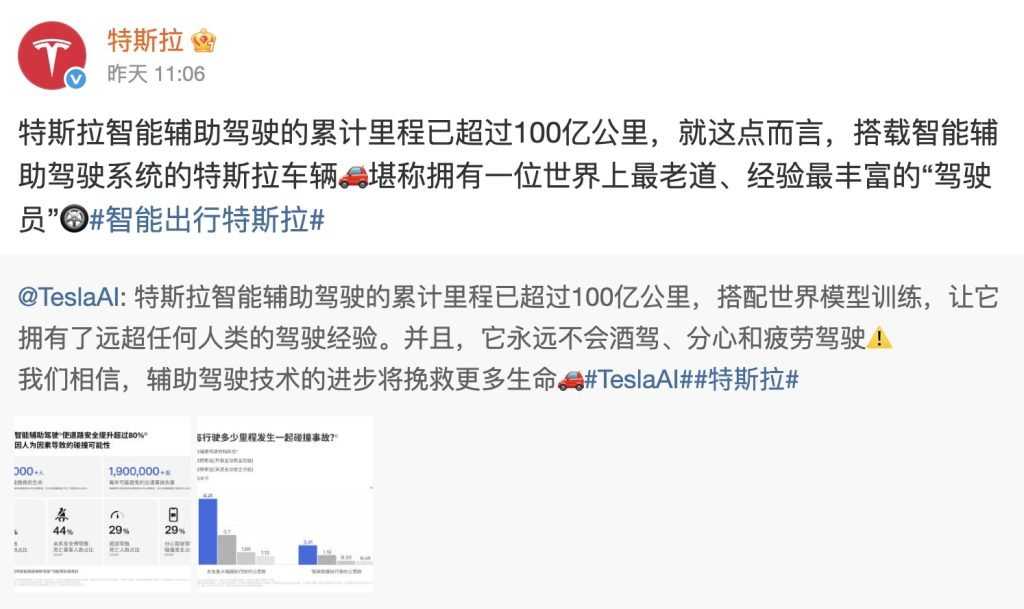
Elon Musk’s 10-billion-km estimate, way back in 2016
When Elon Musk published Master Plan Part Deux, he outlined his vision for the company’s autonomous driving system. At the time, Autopilot was still very new, though Musk was already envisioning how the system could get regulatory approval worldwide. He estimated that worldwide regulatory approval will probably require around 10 billion miles of real-world driving data, which was an impossible-sounding amount at the time.
“Even once the software is highly refined and far better than the average human driver, there will still be a significant time gap, varying widely by jurisdiction, before true self-driving is approved by regulators. We expect that worldwide regulatory approval will require something on the order of 6 billion miles (10 billion km). Current fleet learning is happening at just over 3 million miles (5 million km) per day,” Musk wrote.
It’s quite interesting but Tesla is indeed getting regulatory approval for FSD (Supervised) at a steady pace today, at a time when 10 billion miles of data has been achieved. The system has been active in the United States and has since been rolled out to other countries such as Australia, New Zealand, China, and, more recently, South Korea. Expectations are high that Tesla could secure FSD approval in Europe sometime next year as well.
News
Elon Musk’s Boring Company reveals Prufrock TBM’s most disruptive feature
As it turns out, the tunneling startup, similar to other Elon Musk-backed ventures, is also dead serious about pursuing reusability.
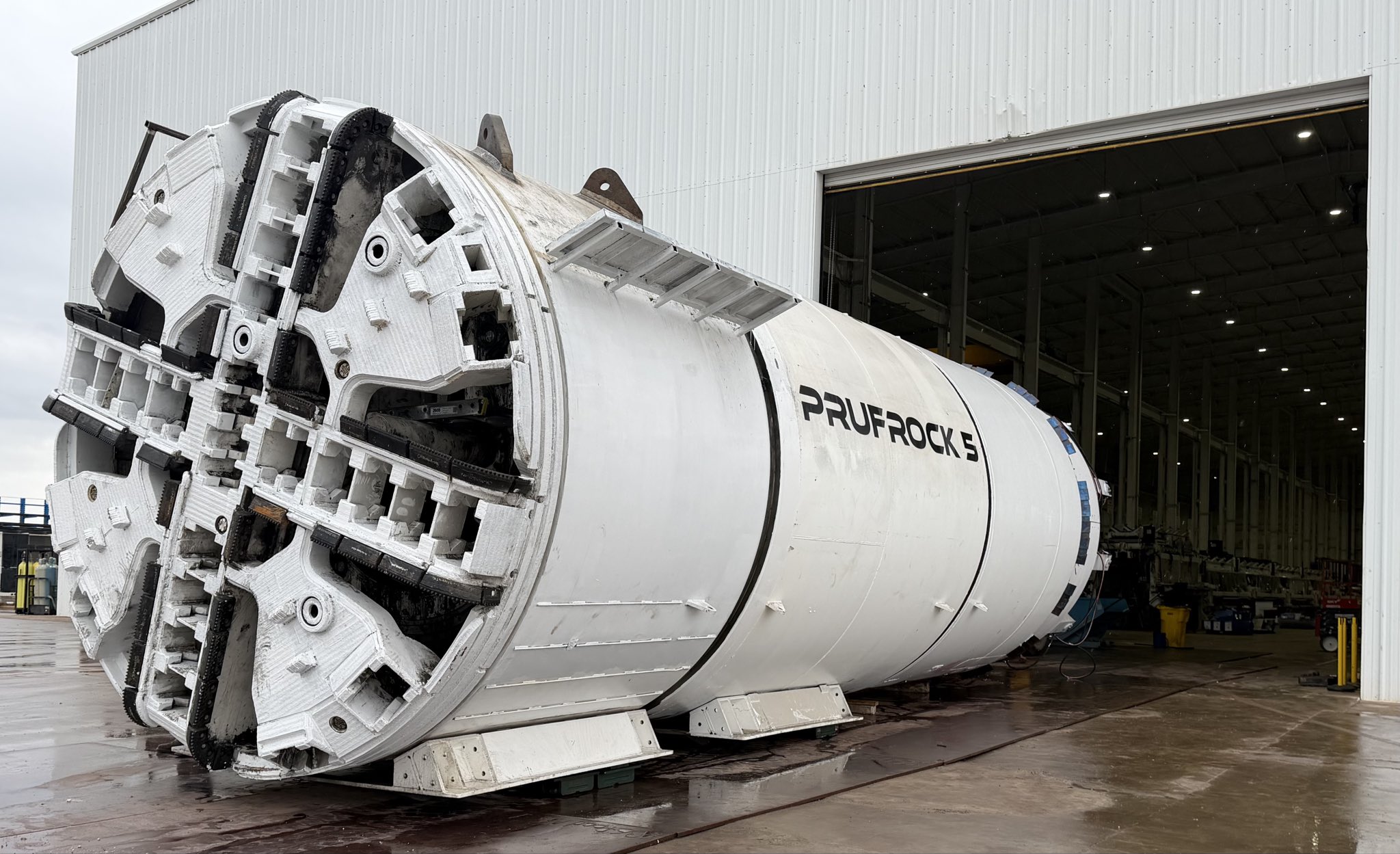
The Boring Company has quietly revealed one of its tunnel boring machines’ (TBMs) most underrated feature. As it turns out, the tunneling startup, similar to other Elon Musk-backed ventures, is also dead serious about pursuing reusability.
Prufrock 5 leaves the factory
The Boring Company is arguably the quietest venture currently backed by Elon Musk, inspiring far fewer headlines than his other, more high-profile companies such as Tesla, SpaceX, and xAI. Still, the Boring Company’s mission is ambitious, as it is a company designed to solve the problem of congestion in cities.
To accomplish this, the Boring Company would need to develop tunnel boring machines that could dig incredibly quickly. To this end, the startup has designed Prufrock, an all-electric TBM that’s designed to eventually be fast enough as an everyday garden snail. Among TBMs, such a speed would be revolutionary.
The startup has taken a step towards this recently, when The Boring Company posted a photo of Prufrock-5 coming out of its Bastrop, Texas facility. “On a rainy day in Bastrop, Prufrock-5 has left the factory. Will begin tunneling by December 1. Hoping for a step function increase in speed,” the Boring Company wrote.
Prufrock’s quiet disruption
Interestingly enough, the Boring Company also mentioned a key feature of its Prufrock machines that makes them significantly more sustainable and reusable than conventional TBMs. As per a user on X, standard tunnel boring machines are often left underground at the conclusion of a project because retrieving them is usually more expensive and impractical than abandoning them in the location.
As per the Boring Company, however, this is not the case for its Prufrock machines, as they are retrieved, upgraded, and deployed again with improvements. “All Prufrocks are reused, usually with upgrades between launches. Prufrock-1 has now dug six tunnels,” the Boring Company wrote in its reply on X.
The Boring Company’s reply is quite exciting as it suggests that the TBMs from the tunneling startup could eventually be as reusable as SpaceX’s boosters. This is on brand for an Elon Musk-backed venture, of course, though the Boring Company’s disruption is a bit more underground.
News
Tesla accused of infringing robotics patents in new lawsuit
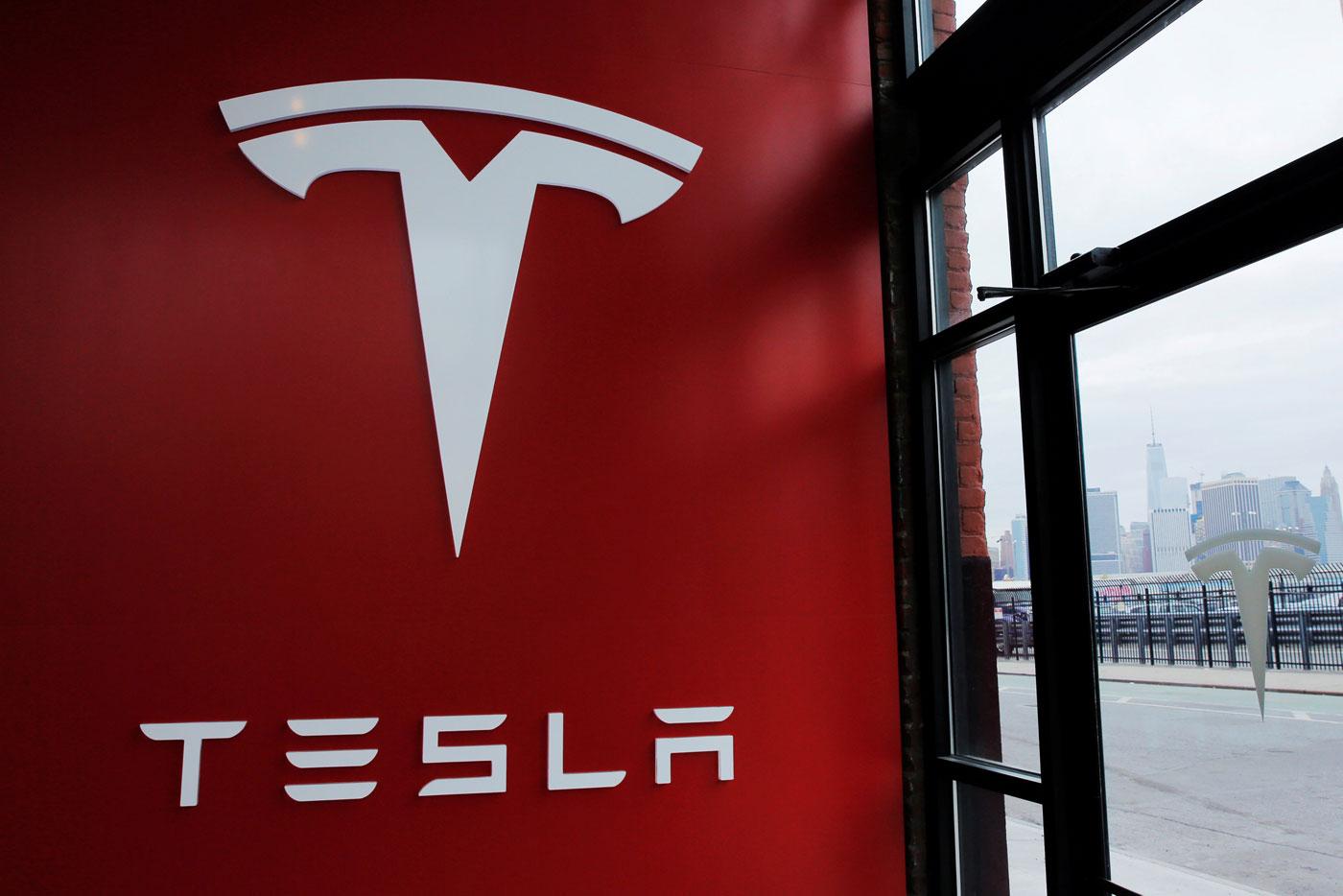
Tesla is being accused of infringing robotics patents by a company called Perrone Robotics, which is based out of Charlottesville, Virginia.
The suit was filed in Alexandria, Virginia, and accuses Tesla of knowingly infringing upon five patents related to robotics systems for self-driving vehicles.
The company said its founder, Paul Perrone, developed general-purpose robotics operating systems for individual robots and automated devices.
Perrone Robotics claims that all Tesla vehicles utilizing the company’s Autopilot suite within the last six years infringe the five patents, according to a report from Reuters.
Tesla’s new Safety Report shows Autopilot is nine times safer than humans
One patent was something the company attempted to sell to Tesla back in 2017. The five patents cover a “General Purpose Operating System for Robotics,” otherwise known as GPROS.
The GPROS suite includes extensions for autonomous vehicle controls, path planning, and sensor fusion. One key patent, U.S. 10,331,136, was explicitly offered to Tesla by Perrone back in 2017, but the company rejected it.
The suit aims to halt any further infringements and seeks unspecified damages.
This is far from the first suit Tesla has been involved in, including one from his year with Perceptive Automata LLC, which accused Tesla of infringing on AI models to interpret pedestrian/cyclist intent via cameras without licensing. Tesla appeared in court in August, but its motion to dismiss was partially denied earlier this month.
Tesla also settled a suit with Arsus LLC, which accused Autopilot’s electronic stability features of infringing on rollover prevention tech. Tesla won via an inter partes review in September.
Most of these cases involve non-practicing entities or startups asserting broad autonomous vehicle patents against Tesla’s rapid iteration.
Tesla typically counters with those inter partes reviews, claiming invalidity. Tesla has successfully defended about 70 percent of the autonomous vehicle lawsuits it has been involved in since 2020, but settlements are common to avoid discovery costs.
The case is Perrone Robotics Inc v Tesla Inc, U.S. District Court, Eastern District of Virginia, No. 25-02156. Tesla has not yet listed an attorney for the case, according to the report.









